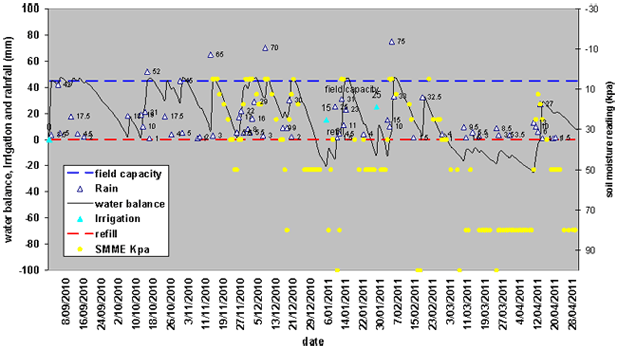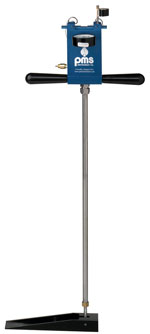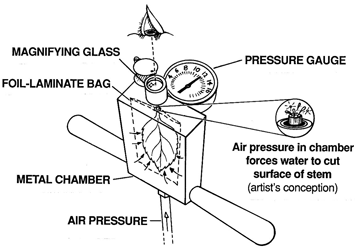IrriGate Newsletter, Issue 6 Autumn/Winter 2011
Download the PDF version of this document: Irrigate Newsletter - Issue 6 - Autumn/Winter 2011 (PDF 500 KB)
To view the information PDF requires the use of a PDF reader. This can be installed for free from the Adobe website (external link).
Sustainable Irrigated Landscapes - North East - Mid and Upper Goulburn Broken
 |  |
| North East Dryland Catchment | Goulburn Broken Dryland Catchment (excluding the Shepparton Irrigation Region) |
Welcome to IrriGate Issue 6.
I would like to take this opportunity to say farewell, I will be relocating to DPI Wangaratta to take up a new position. I have enjoyed my time with irrigation immensely, meeting and getting to know you all, originally with Water for Growth and Project Leader John Nieuwenhius and in recent times with Water Smart Farms and Project Leader Dennis Watson.
Best Wishes Wendy Paglia - Editor
Tracking water requirement over the season | Monitoring the plant’s moisture not the soils | Contact Us
Tracking water requirement over the season
What an unusual irrigation season this one has been. The majority of irrigators across the region only irrigated 2 to 3 times over the season; some not at all. Figure 1 shows an example of a theoretical water budget for lucerne grown in the Myrtleford area over the 2010/2011 irrigation season. The blue line indicates a water filled soil profile, while below the red line indicates plant stress. In this case only two irrigation events occurred, 15 mm applied on the 5 January and 25 mm applied on the 28 January indicated on the graph by the light blue triangles. This with the addition of rainfall was enough to just about keep the water balance out of a negative state, until the start of March. Another irrigation at this point in hind sight could have been useful. However given the rainfall events prior, at the time it made sense not to irrigate and exacerbate potential water logging issues as winter approaches.

Figure 1: Water balance of lucerne over the 2010-2011 irrigation season
The yellow dots on the graph are soil moisture readings shown in Kpa using the scale on the right hand side of the graph. These were recorded from a “G-dot” installed at 30 cm. The soil moisture readings correlate pretty well with the theoretical water balance.
i.e. when the theoretical water balance is indicating the soil moisture is adequate the probe is saying the same thing, and when the water balance is getting dry the probe reflects this.
Monitoring the plant’s moisture not the soils
A number of irrigators are striving to improve water use efficiency by measuring the level of moisture stored in the soil to determine if irrigation should occur and how much water should be applied. There is a myriad of equipment out there that can help do this. There is however other equipment which can measure moisture stress directly from the plant. There are a couple of benefits of doing this.
This can be a little bit awkward and time consuming to use in the field on a daily basis but can provide some very useful information at strategic times throughout the irrigation season. The “Pump-Up Pressure Chamber” is more commonly used in horticulture than the fodder industry. This units sell for approximately $1,500, but remember you may be eligible for a 50% rebate. More information can be found on the following website. www.pmsinstrument.com (external link) |  Figure 2: Pump-Up Pressure Chamber |

Figure 3: Diagram a leaf in the Pump-Up Pressure Chamber
DPI NE/GB Sustainable Irrigation Team - Dryland
| Dennis Watson Irrigation specialist DPI Rutherglen Centre (02) 6030 4567 0429 304 567 dennis.watson@dpi.vic.gov.au |  Dennis Watson |
| Ian Gamble Catchment Management Officer DPI Wangaratta Centre (03) 5723 8671 0437 362 620 ian.gamble@dpi.vic.gov.au |  Ian Gamble |
| Wendy Paglia Project Support Officer DPI Ovens Centre (03) 5731 1206 wendy.paglia@dpi.vic.gov.au |  Wendy Paglia |
If you would like to receive this information/publication in an accessible format (such as large print or audio) please call the Customer Service Centre on: 136 186, TTY: 1800 122 969, or email customer.service@dpi.vic.gov.au
Published by the Department of Primary Industries, Sustainable Irrigated Landscapes, March 2011,
© The State of Victoria, 2011
This publication is copyright. No part may be reproduced by any process except in accordance with the provisions of the Copyright Act 1968.
Authorised by the Victorian Government, 1 Spring Street, Melbourne 3000
ISSN :1837-4077
Disclaimer:
This publication may be of assistance to you but the State of Victoria and its employees do not guarantee that the publication is without flaw of any kind or is wholly appropriate for your particular purposes and therefore disclaims all liability for any error, loss or other consequence which may arise from you relying on any information in this publication.
For more information about DPI go to www.dpi.vic.gov.au or call the Customer Call Centre on 136 186.


